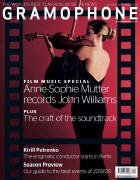Texte paru dans: / Appeared in: |
|
|
Outil de traduction (Très approximatif) |
|
|
Reviewer:
David Vickers Recorded live in the church of St Wenceslas in Naumburg, this assortment of four cantatas features its magnificent historic organ built by Zacharias Hildebrandt and tested by Bach in 1746. Two years later Hildebrandt became chief overseer of church organs in Leipzig, where he had already been Bach’s harpsichord tuner since the mid-1730s. Appropriately for a Michaelmas concert, the first and last cantatas are both for the feast of St Michael the Archangel, whose princely role as the leader of heaven’s armies against Lucifer is reflected in Bach’s use of three trumpets, timpani and rich woodwind in both No 19, Es erhub sich ein Streit (1726), and No 149, Man singet mit Freuden vom Sieg (1728/29). The orchestra and choir of Gaechinger Cantorey are conducted expertly by Hans-Christoph Rademann; ebullient trumpet-laden choruses fizz with a compound of sonorous muscle, rhythmic flair and contrapuntal transparency, nowhere more so than the convivial opening chorus of No 149 (parodied from the Hunt Cantata). The centrepiece of No 19 is the E minor siciliano ‘Bleibt, ihr Engel, bleibt bei mir!’, sung compassionately by Benedikt Kristjánsson; its harmonically rich string parts are shaped perfectly and its high trumpet chorale tune is played gently by Hans-Martin Rux-Brachtendorf. The closing chorale is replete with improvised flourishes from the awe-inducing organ between phrases. The intervening solo cantatas advocate God’s peace. The Hildebrandt organ takes centre stage in No 169, Gott soll allein mein Herze haben (for the 18th Sunday after Trinity, 1726), all three movements probably adapted from a lost keyboard concerto. There is a thrilling synergy between organist David Franke (exploiting the instrument’s spectacular registrations) and the alert orchestra (further enriched by two oboes d’amore and taille) in the Sinfonia; the dramatic singing of Anke Vondung conveys darkhued wisdom. No 158, Der Friede sei mit Dir (date unknown), seems to be for either Candlemas or the third day of Easter, and might not be preserved intact; Peter Harvey’s solicitous Vox Christi in the first recitative leads into an articulate dialogue aria with Nadja Zwiener’s concertante violin (‘Welt, ade, ich bin dein müde’). There are an excellent essay by Holger Schneider of Stuttgart’s International Bach Academy and eye-catching illustrations, but no sung texts or translations. |
|




